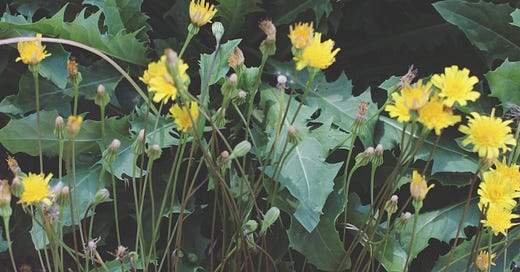Loam Love is a series within our Substack. Each month, we’ll share a curated missive from one of our contributors on some of the perspectives and projects that are shaping their current praxis.
This February, Caitlin Duquette—author of the beloved essay ‘Herbs for Resilience’ from our 2022 issue—is sharing some of what’s on her mind. “A multidisciplinary and a mountain ridge line from Maui, Hawaii,” Caitlin’s work is dedicated to supporting “fellow Indigenous and land-centered communities, artists, healers, and projects.” From facilitating herbal mutual aid projects to writing at the intersections of community care, environmentalism, and representation, Caitlin continues to inspire us at Loam.
PHOTO BY KAILEA LOFTEN
WHO I’M WATERING
Recently, two hāhā (Cyanea sp.) were gifted to me by a plant friend. Although these plants are considered “common” species within the Cyanea family, they’re still rare and critically threatened endemic Hawaiian plants. Hāhā of Maui are usually found in the bogs tucked deep into mountainous valleys, accessible only by authorized helicopter and tended to by trained land stewards in state or federal arenas. How they made their way to me in Maui’s dryer lower elevation is unknown. As they grow daily, I look upon them with wonder and reverence: two tiny kūpuna whose descendants may one day make it back to a valley and if not, still perpetuate life.
WHAT I’M READING
There are certain books out there that, when they show up at the right time in your life, obligate you to drop everything you’re currently consuming and commit to it. Although Kū Kanaka–Stand Tall: A Search for Hawaiian Values by George S. Kanahele has been sitting on our bookshelf for years, I’ve recently found it resonating. By adapting ancient Hawaiian knowledge to contemporary times, Kanahele draws the reader into depths such that even literary experts of Hawaiian culture may find something new to consider. Kū Kanaka not only shows us a glimpse of how Hawaiians thought, behaved, and related with their world before European contact, but also decenters white settler colonialism through illuminating native intelligence.
WHAT REMEDIES I’M TURNING TO
In our complex world, I’m drawn to the simplicity of drinking just one plant instead of trying out tricky formulations. Lately, I’ve been drinking hot ʻuhaloa (Waltheria indica) infusions to support my respiratory system. Native to Hawaiʻi, Kānaka Maoli have used ʻuhaloa for centuries for the health of the lungs and stomach, among other conditions. Since tourism swelled on Maui after the 2023 August fires, new varieties of contagions have been circulating in our system. Compounded by harmful dust from topsoil sprayed with herbicide, as well as toxic fumes from burn zones, the air quality right now is rough.
If you don’t have the eye for it, ʻuhaloa could appear unattractive, straggly and weed-like. It loves challenged and disturbed soil and is often found thriving where most plants struggle, including lava fields, empty poisoned lots, and dry areas of the islands.
WHAT’S ON MY HEART
Witnessing major events happening in real-time—such as the August 2023 fires in Lahaina and Kula, Maui—has made my heart long to learn how to manage polarization. The devastating fires continue to teach me about how to practice intentionality when it comes to both community care and personal care.
At this time, my personal care includes tending to the closest branches of my own ecosystem. Focusing on my family is allowing me to sharpen my attention and build my strength so that I can care for community from a more grounded place.
Check out the Loam Loves archives below!




